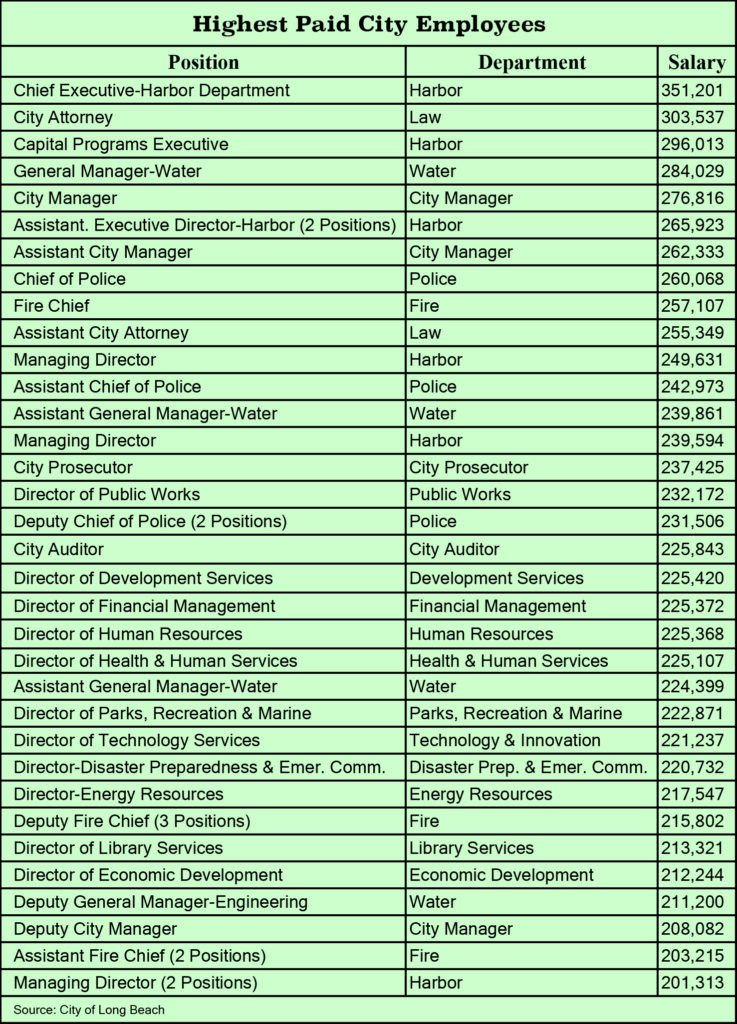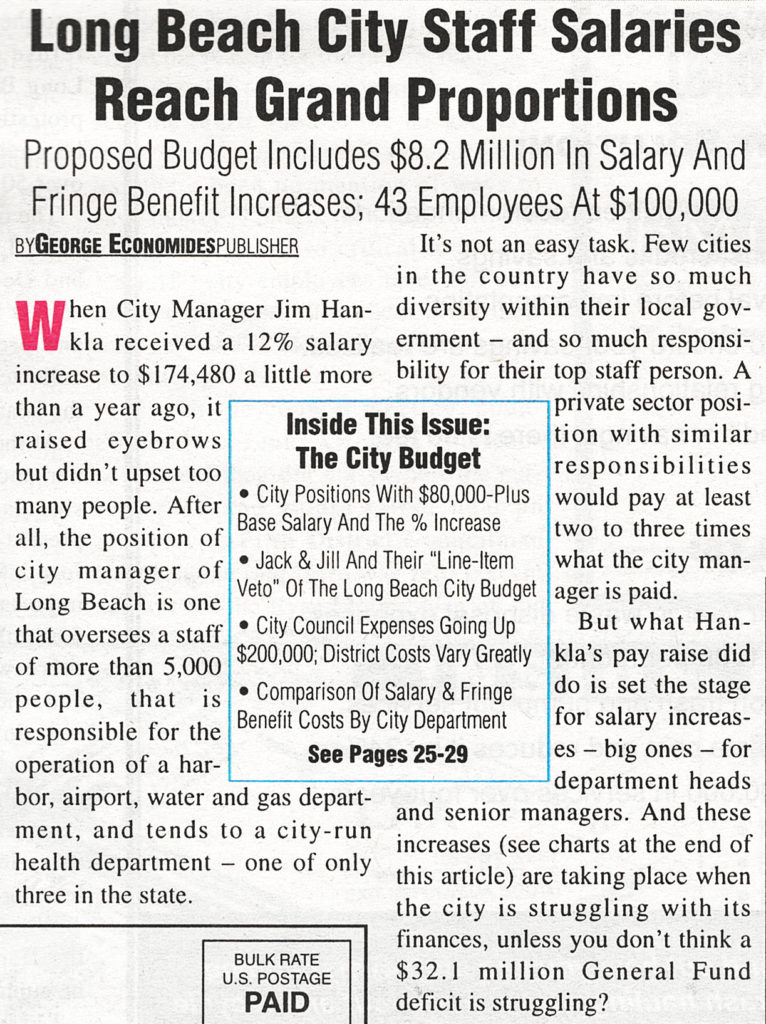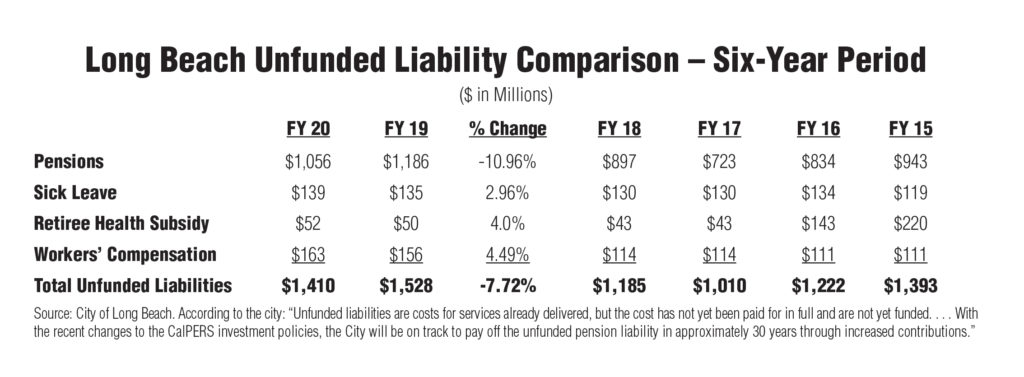In 1997, George Economides, founding publisher of the Long Beach Business Journal, coined the phrase “$100,000 Club” in an analysis he published about rising city salaries. At the time, there were 43 members of this then-limited club, each a city employee earning $100,000 or more. Today, as the group has grown to a decidedly less exclusive 1,606 members, a new elite club of 40 high-paid city earners has emerged: the $200,000 Club.
City staffers earning $200,000 or more are all management level and highly specialized positions, according to City Manager Patrick West. They include the directors of city departments, as well as some deputy directors and second-in-command positions.
Based on August 1, 2019 paychecks, the highest paid employee in the City of Long Beach is the executive director of the Port of Long Beach, with a salary of $351,201. The only other person on the city payroll earning a $300,000-plus salary is the elected city attorney, who now earns $303,537 annually, an amount dictated by the city charter.
Since the late 1990s, the Business Journal has annually published an analysis of city salaries, detailing the evolution of the $100,000 Club by analyzing city budget documents. In 2009, West offered to directly provide data to the newsmagazine, and every year since that time we have met with West and some of his staff to discuss salaries, pensions, overtime and more. West sat down with the Business Journal for this annual interview one last time on August 16 – he departs the position on September 20 to pursue consulting in the private sector.
About 28%, almost one-third, of city staff are earning $100,000 or more, based on data provided by West’s office. Between August 1, 2018 and the same day in 2019, there was a 4% increase in $100,000 club members.
Geoffrey Hall, assistant to the city manager, told the Business Journal that pay increases reflected in August 1, 2019 payroll data he provided ranged from 2-15%.
Over the past 10 years, $100,000 Club membership has increased from 579 employees to 1,606. The vast majority – 59.3% – of $100,000 club members are public safety employees in the police and fire departments. This is what it takes to attract and retain talent in public safety in order to be competitive with departments in nearby cities, according to city management.
Total city payroll for 5,709 employees amounts to $476,175,548, a 3% increase compared to August 1, 2018, when there were 35 fewer city employees on the payroll. Over the past two years, city payroll has increased 9.5%, while total staffing has increased by about 1%, based on data provided by the city manager’s office.
As of August 1, there were 358 city employees earning $90,000 to $99,000, a 23% increase compared to 2018. The majority, 38.3%, of these positions are in departments overseen by the city manager. Following closely behind are the police and fire departments, which employ 36% of city positions in this salary range.
The city is currently negotiating with all 11 of the union bargaining units representing city employees. When new contract terms were agreed upon in 2012, $100,000 Club membership increased by 45%. Assistant City Manager Tom Modica told the Business Journal that this spike was in part due to a change in pension formulas – employees were required to increase their contributions to their pensions, and to help ease the burden, they got higher pay bumps.
Club membership increased by 27% under new memoranda of understanding with labor groups in 2017. Given this trend, and the number of city employees already earning nearly $100,000, it’s likely that the number of earners in this salary class will again significantly increase once new labor contracts are hashed out.
Shortly thereafter, Long Beach voters will be asked in March 2020 whether to approve the Measure A sales tax for three key reasons: to maintain and, when possible, increase public safety staffing; to fund infrastructure improvements; and to pay down the city’s commitment to the seismic upgrades needed to reopen (and keep open) Community Hospital.

West and Modica maintain that the City of Long Beach’s payroll reflects what must be paid to remain competitive in attracting talent. “Basically all of our department heads are making over $200,000. That’s a fact, and that’s what it takes to get a department head to work at one of the largest cities in America,” West said.
In the past three years, there has been noticeable turnover among department heads. The city’s technology, fire, parks, and development services departments, as well as the Long Beach Airport, have all had their top positions turn over. According to Modica, the City of Long Beach offers comparatively lower salaries for top department positions in contrast to some other Southern California cities; often, these are cities that tend to be smaller, with fewer financial burdens. West said this is at least “a little bit” of a factor in the turnover the city’s top positions have experienced.
It’s true that other cities have a history of snatching up Long Beach department heads, and, for that matter, public safety personnel. So if any Long Beach taxpayers reading this are befuddled or even frustrated by ever-increasing municipal salary levels that many average private sector employees could never dream of (the household income in Long Beach is around $60,000 a year, for example – and when was the last time you heard of a private sector employee with a pension?), perhaps they need to take up their issue on a broader basis. Is it time for a statewide conversation about government salaries and pensions, and how they’re serving the public interest?
Pensions And Unfunded Liabilities
Total unfunded personnel-related liabilities in FY 2020 amount to $1.4 billion – an amount that takes into account pensions, workers’ compensation, general liability insurance, and retiree sick leave and health insurance subsidies. Pensions make up about 75% of the city’s total unfunded liabilities.
According to the Proposed Fiscal Year 2020 budget, the City of Long Beach is projected to spend $154.1 million across all city funds on pensions, $91.3 million of which is budgeted in the General Fund. General Fund pension costs increased by $6.8 million from FY 2019 to FY 2020, according to the budget.
 Although challenges remain, the City of Long Beach has done more, and did so sooner, to tackle pension reform than many other California cities. In 2006, then-Mayor Bob Foster convinced the city council and union groups to implement changes to pension payment formulas. This included the creation of a second tier for new hires that changed the percentage used in determining an employees’ pension payment obligation and raised the age at which pension benefits would begin. According to the Fiscal Year 2020 budget, the city’s pension reform efforts are saving the city about $14 million per year.
Although challenges remain, the City of Long Beach has done more, and did so sooner, to tackle pension reform than many other California cities. In 2006, then-Mayor Bob Foster convinced the city council and union groups to implement changes to pension payment formulas. This included the creation of a second tier for new hires that changed the percentage used in determining an employees’ pension payment obligation and raised the age at which pension benefits would begin. According to the Fiscal Year 2020 budget, the city’s pension reform efforts are saving the city about $14 million per year.
For the first time in six years, the city’s total unfunded liabilities decreased in the Fiscal Year 2020 budget compared to the prior year. In Fiscal Year 2019, total unfunded liabilities amounted to about $1.5 billion, and in Fiscal Year 2020 they are estimated at about $1.4 billion. As outlined in the Fiscal Year 2020 budget proposal, the city is on track to pay off its unfunded pension liability in about 30 years, according to estimates by CalPERS, the California Public Employees’ Retirement System.
Union Membership
After the U.S. Supreme Court ruled in 2018 that unions cannot require members to pay dues, the city’s union groups saw a sharp drop-off in paying members, but the decline now appears to have stabilized. Between July 2017 to July 2018, the percentage of members paying union dues decreased from 88.5% to 65%. Between July 2018 and August 2019, however, the percentage of dues paying members slightly increased to about 67%.
About 53% of members of the largest city employee union, the International Association of Machinists & Aerospace Workers, pay dues. This union has the smallest share of dues-paying members compared to other employee groups, although this percentage remained about the same from 2018 to 2019.
A Note On $200,000 Club Salary Listings:
– Salary amounts were derived by multiplying the employee’s hourly rate as of August 1, 2019 by 2,088 hours
– Salary amounts for Long Beach police and Fire Department employees include skill pay but do not include overtime
– All employees now pay the full employee share of pension costs (9% for police and fire, 8% for all others)

